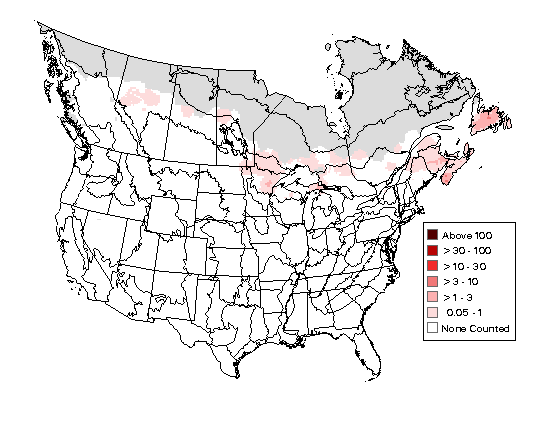Birdfinding.info ⇒ In October and November, becomes common along the Atlantic coast of the U.S. Common in winter throughout Florida, the Bahamas, and the Greater Antilles. Adapts to most semiopen seaside habitats, including dunes, marshes, and beachfront resorts.
Palm Warbler
Setophaga palmarum
Breeds in the boreal forest zone of North America. Winters from the southeastern U.S. to the West Indies and Central America.
Consists of two distinct forms: “Western Palm Warbler” (palmarum) and “Yellow Palm Warbler” (hypochrysea).
Breeding. Spruce and tamarack bogs, and similar open, boggy habitats with scattered small conifers, from the southeastern Yukon to Newfoundland, south to northern Wisconsin, Michigan, New York, and Maine. The transition zone between the “Western” and “Yellow” is in western Quebec, just east of James Bay.
Nonbreeding. Wetlands, scrub, fields, and coastal habitats from the Mid-Atlantic states and eastern Texas south through the Bahamas, Greater Antilles, Virgin Islands, western Caribbean islands, and Yucatán Peninsula to the Caribbean lowlands of Nicaragua. Also winters regularly in small numbers along the Pacific coast of the U.S. and Mexico. Stragglers appear in winter anywhere from southern Canada to Panama, the ABC Islands, and the Lesser Antilles.
“Western Palm Warbler” is widespread across the winter range described above. “Yellow Palm Warbler” is concentrated in the U.S. Gulf Coast lowlands from Louisiana to Georgia and northern Florida, but also winters in small numbers in the West Indies.
Movements. The two forms have very different migratory patterns:
“Western Palm Warbler” migrates mainly west of the Appalachians in spring, with the vast majority passing through the Great Lakes in early May. In fall, it is more dispersed, with large numbers following the Atlantic coast southward, and small numbers appearing throughout the U.S. Its fall migration stretches from early August to November, with many individuals remaining to overwinter well north of the usual winter range.
“Yellow Palm Warbler” follows the Eastern Seaboard in both directions and is one of the earliest spring migrants, departing in March and arriving on its breeding grounds in late April and early May. It typically remains on its breeding grounds until September and reaches its wintering grounds in October.
Identification
In all plumages, Palm Warbler can usually be recognized by its persistent tail-wagging and largely terrestrial habits.
In breeding plumage, both “Western” and “Yellow” have a vivid chestnut cap, pronounced eyebrow and eyeline, dark cheek, and brown or chestnut streaks on the breast, flanks, and back. The sexes are similar.

“Western Palm Warbler,” S. p. palmarum, breeding plumage. (Dominican Republic; March 5, 2016.) © Dax M. Román E.
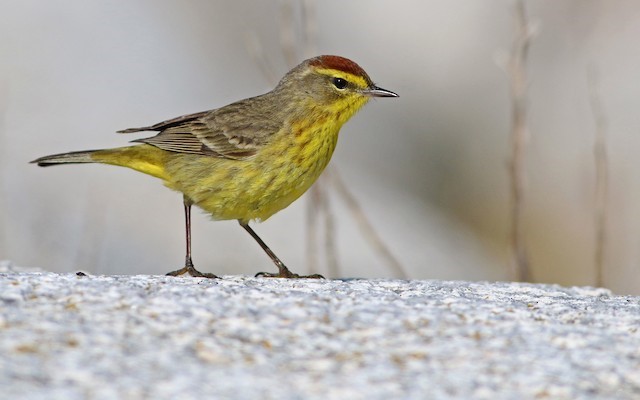
“Yellow Palm Warbler,” S. p. hypochrysea, breeding plumage. (Seal Island National Wildlife Refuge, Maine; May 3, 2015.) © Keenan Yakola
Both forms have mostly brownish upperparts with vague streaking or mottling. “Western” is typically grayish-brown, whereas “Yellow” has to have an olive tinge.
The forms differ most noticeably in the coloration of the underparts: “Western” has a bright yellow throat, chest, and vent, and its lower breast and belly are off-white with a yellowish wash; “Yellow” is a rich shade of yellow from the throat to the vent.

“Western Palm Warbler,” S. p. palmarum, breeding plumage. (Summit, Utah; April 30, 2016.) © Kenny Frisch

“Western Palm Warbler,” S. p. palmarum, breeding plumage. (Santa Lucia, Camagüey, Cuba; March 18, 2018.) © Hélène Crête

“Yellow Palm Warbler,” S. p. hypochrysea, breeding plumage. (Susquehanna Riverlands, Wapwallopen, Pennsylvania; April 18, 2018.) © Rick Koval

“Western Palm Warbler,” S. p. palmarum, breeding plumage. (Pole Bridge Creek Wastewater Treatment Plant, Stonecrest, Georgia; April 14, 2018.) © Michael Linz
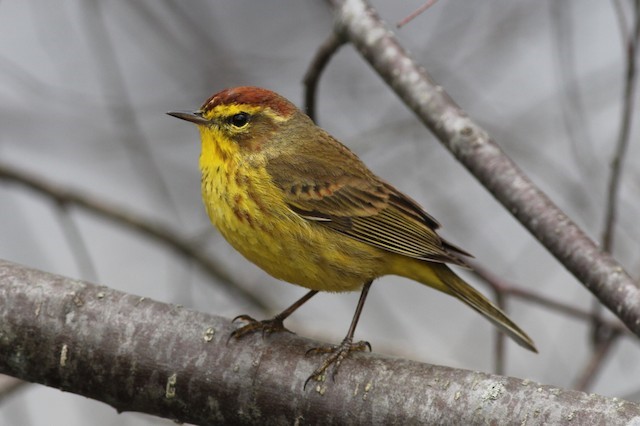
“Yellow Palm Warbler,” S. p. hypochrysea, breeding plumage. (Messalonskee Lake, Maine; April 16, 2013.) © Margaret Viens

“Western Palm Warbler,” S. p. palmarum, breeding plumage. (Santo Domingo, Dominican Republic; March 5, 2016.) © Dax M. Román E.

“Western Palm Warbler,” S. p. palmarum, breeding plumage. (East Grand River Park, Grand Haven, Michigan; May 5, 2018.) © Brendan Klick
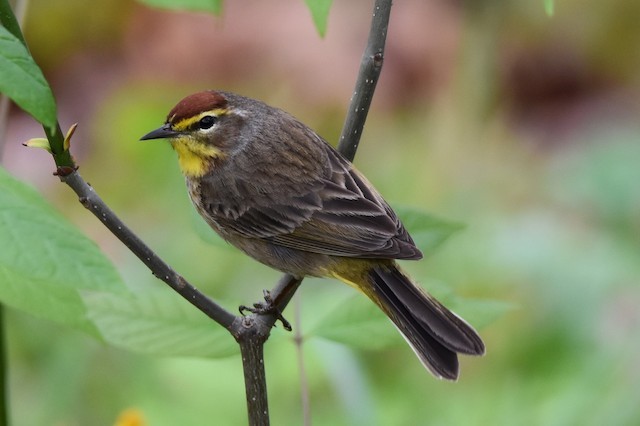
“Western Palm Warbler,” S. p. palmarum, breeding plumage—an unusually dark individual. (Lake Junaluska, North Carolina; April 25, 2017.) © Timothy Carstens

“Yellow Palm Warbler,” S. p. hypochrysea, breeding plumage. (Lake Wallace, Massachusetts; April 14, 2018.) © Devin Griffiths
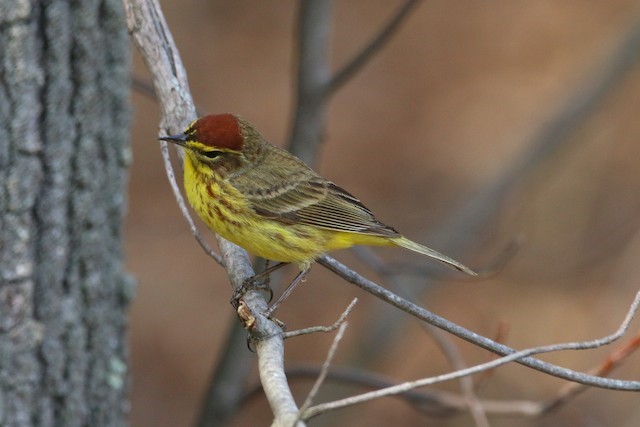
“Yellow Palm Warbler,” S. p. hypochrysea, breeding plumage, showing crisply defined chestnut cap. (Lake Wallace, Massachusetts; April 14, 2018.) © Devin Griffiths
Immature and nonbreeding adult plumages are pale, drab, washed-out versions of the breeding plumage. The characteristic markings—pale eyebrows, dark eyelines, and streaked breasts—are usually detectable, but muted.
Nonbreeding “Westerns” typically retain their contrastingly bright yellow vent and yellowish rump.
Nonbreeding “Yellows” are mostly pale yellow below—usually somewhat brighter on the vent, but the contrast is not always noticeable.
Some immatures are so nondescript as to be nearly unidentifiable apart from their distinctive tail-wagging behavior—most resembling pipits both in this characteristic and in their general appearance.

“Western Palm Warbler,” S. p. palmarum, nonbreeding plumage—note the contrasting bright yellow vent. (Ancón Peninsula, Cuba; February 17, 2015.) © Joshua D. Vandermeulen
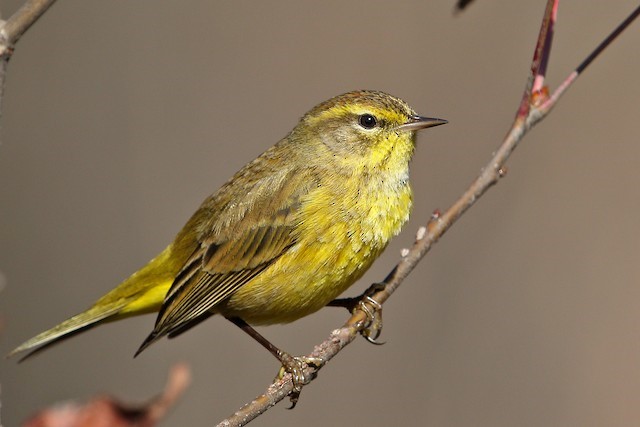
“Yellow Palm Warbler,” S. p. hypochrysea, nonbreeding plumage. (Black Creek Ravines Conservation Area, Clay County, Florida; January 24, 2018.) © Steve Raduns

“Western Palm Warbler,” S. p. palmarum, nonbreeding plumage. (Playa Pesquero, Holguín, Cuba; February 23, 2018.) © Suzanne Labbé

“Yellow Palm Warbler,” S. p. hypochrysea, immature or nonbreeding adult. (Nanticoke Lake, Lisle, New York; October 13, 2017.) © George Chiu
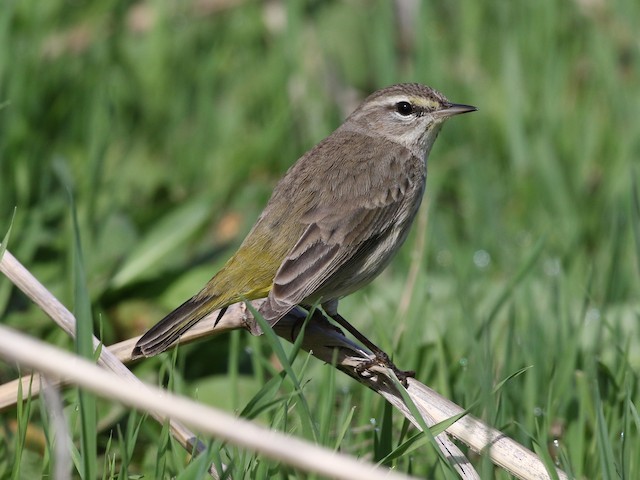
“Western Palm Warbler,” S. p. palmarum, immature or nonbreeding adult. (Savannah National Wildlife Refuge, Georgia; February 14, 2018.) © Steve Calver
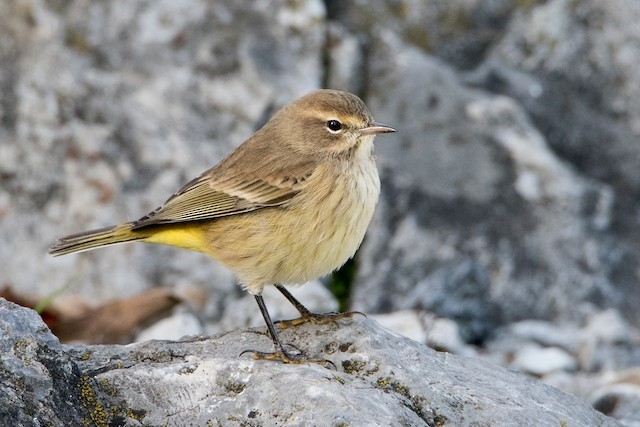
“Western Palm Warbler,” S. p. palmarum, immature or nonbreeding adult. (Times Beach Nature Preserve, Buffalo, New York; October 5, 2018.) © Sue Barth

“Western Palm Warbler,” S. p. palmarum, molting into breeding plumage—note deep chestnut in cap and yellow emerging on the throat. (Corkscrew Swamp Sanctuary, Florida; March 2, 2009.) © Knut Hansen

“Western Palm Warbler,” S. p. palmarum, immature or nonbreeding adult—note the conrasting yellow vent and yellowish rump. (Greene Valley Forest Preserve, Illinois; September 17, 2017.) © Paul Clifford
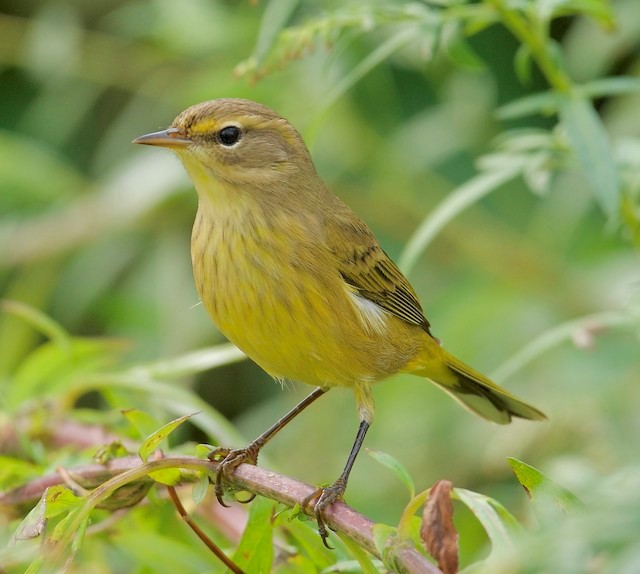
“Yellow Palm Warbler,” S. p. hypochrysea, immature. (Stratford, Connecticut; October 1, 2018.) © Linda Olsen

“Western Palm Warbler,” S. p. palmarum, nonbreeding plumage—note the contrastingly bright yellow vent and white undertail patches. (Hagerman National Wildlife Refuge, Texas; January 4, 2017.) © Mike Chiles

“Yellow Palm Warbler,” S. p. hypochrysea, immature or nonbreeding adult. (Queenstown, Maryland; November 16, 2018.) © Daniel Irons

“Western Palm Warbler,” S. p. palmarum, immature or nonbreeding adult. (Everglades National Park, Florida; February 3, 2009.) © Paul Cools

“Western Palm Warbler,” S. p. palmarum, immature. (Houge Park, San Jose, California; November 14, 2018.) © Brooke Miller

“Yellow Palm Warbler,” S. p. hypochrysea, immature. (Boston Nature Center Wildlife Sanctuary, Boston, Massachusetts; October 22, 2018.) © Ryan Schain

“Western Palm Warbler,” S. p. palmarum, nonbreeding plumage. (Rancho San Vicente, Ancón, Pinar del Río, Cuba; December 12, 2016.) © Dan Maxwell
Notes
Polytypic species consisting of two subspecies that are distinct forms: “Western Palm Warbler” (palmarum) and “Yellow Palm Warbler” (hypochrysea).
References
Alderfer, J., and J.L. Dunn. 2014. National Geographic Complete Birds of North America (Second Edition). National Geographic Society, Washington, D.C.
Dunn, J. L., and K. L. Garrett. 1997. A Field Guide to Warblers of North America. Houghton Mifflin, Boston.
eBird. 2019. eBird: An online database of bird distribution and abundance. Cornell Lab of Ornithology, Ithaca, N.Y. http://www.ebird.org. (Accessed March 8, 2019.)
Fagan, J., and O. Komar. 2016. Peterson Field Guide to the Birds of Northern Central America. Houghton Mifflin Harcourt, New York.
Garrido, O.H, and A. Kirkconnell. 2000. Field Guide to the Birds of Cuba. Cornell University Press, Ithaca, N.Y.
Garrigues, R., and R. Dean. 2014. The Birds of Costa Rica: A Field Guide (Second Edition). Cornell University Press, Ithaca, N.Y.
Haynes-Sutton, A., A. Downer, R. Sutton, and Y.-J. Rey-Millet. 2009. A Photographic Guide to the Birds of Jamaica. Princeton University Press, Princeton, N.J.
Howell, S.N.G., and S. Webb. 1995. A Guide to the Birds of Mexico and Northern Central America. Oxford University Press, Oxford.
Latta, S., C. Rimmer, A. Keith, J. Wiley, H. Raffaele, K. McFarland, and E. Fernandez. 2006. Birds of the Dominican Republic and Haiti. Princeton University Press, Princeton, N.J.
Raffaele, H. 1989. A Guide to the Birds of Puerto Rico and the Virgin Islands. Princeton University Press, Princeton, N.J.
Raffaele, H., J. Wiley, O. Garrido, A. Keith, and J. Raffaele. 1998. A Guide to the Birds of the West Indies. Princeton University Press, Princeton, N.J.
Ridgely, R.S., and J.A. Gwynne. 1989. A Guide to the Birds of Panama (Second Edition). Princeton University Press, Princeton, N.J.
Salt, W.R., and J.R. Salt. 1976. The Birds of Alberta. Hurtig Publishers, Edmonton, Alberta.
Wells, J.V., and A.C. Wells. 2017. Birds of Aruba, Bonaire, and Curaçao. Cornell University Press, Ithaca, N.Y.


